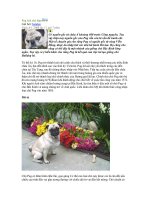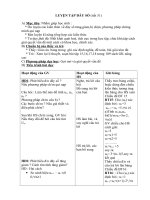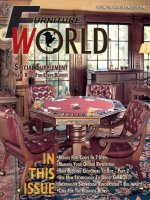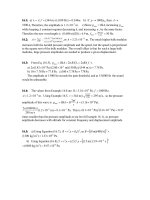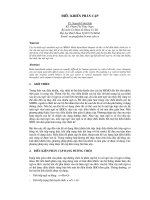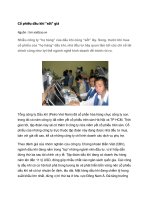Tài liệu physical metallurgy 4e volume1 ppt
Bạn đang xem bản rút gọn của tài liệu. Xem và tải ngay bản đầy đủ của tài liệu tại đây (30.38 MB, 1,042 trang )
1
Phqsical
Me
tallurgq
Robert
W.
Cahn
and Peter
Haasen
(-0,
editors
-
I
FOURTH,
REVISED
AND
ENHANCED
EDITION
NO-
I
Prof:
Robcrt
W.
Cahn.
editor
PHYSICAL
METALLURGY
VOLUME
I
LIST
OF
CONTRIBUTORS
A.S.
Argon
E.
Ant
H.
K.
D.
H. Bhadeshia
H.
Biloni
J.
L Bocquet
W.
J.
Boettinger
G. Brebec
R.
W. Cahn
G.Y.
Chin?
T.W. Clyne
R.D.
Doherty
H.E.
Exner
R.
Ferro
D.R.
Gaskell
H.
Gleiter
A.L.
Greer
P.
Haasen?
J.P.
Hirth
S.
Hofmann
E.D.
Hondros
E.
Hornbogen
G.
Kostorz
C.
Laird
P.
LejEek
W.C. Leslie
Y.
Limoge
J.
D.
Livingston
F.E.
Luborsky
T.
B. Massalski
J.
R.
Nicholls
AD.
Pelton
D.G. Pettifor
D.P. Pope
M.
Riihle
A.
Saccone
S.
R.
J.
Saunders
M.P.
Seah
W. Steurer
J L.
Strudel
R.M.
Thomson
C.M. Wayman
M.
Wilkens
A.H. Windle
H.
J.
Wollenberger
PHYSICAL
METALLURGY
Fourth,
revised and enhanced edition
Edited
by
Robert
W.
CAHN
Peter
HAASEN?
University
of
Cambridge
University
of
Gottingen
VOLUME
I
1996
NORTH-HOLLAND
AMSlXRDAM-JAUSANNE4VEW YORK4XFOWHANNON-TOKYO
ELSEVIER
SCIENCE
B.V.
Sara
Burgemartstraat
25
P.O.
Box
211,1000
AE
Amsterdam,
The
Netherlands
ISBN
0
444
89875
1
0
1996
Elsevier Science
B.V.
All
rights
reserved.
No
part
of
this
publication may
be
reproduced,
stored
in
a
retrieval system or
transmitted
in
any
form
of by
any
means, electronic, mechanical, photocopying, recording
or
otherwise, without
the
prior
written
permission of
the
publisher,
Elsevier
Science
B.V.,
Copyright
&
Permissions
Department, P.O.
Box
521,
lo00
Ah4
Amsterdam,
The Netherlands.
Special
regulations for readers
in
the
U.S.A.
-
This
publication has
been
registered
with
the
Copyright Clearance Center
Inc.
(CCC),
222
Rosewood
Drive, Danvers,
MA
01923.
Information
can
be
obtained from the CCC about conditions
under
which photocopies of paas
of
this
publication may
be
made
in
the U.S.A.
All
other copyright questions, including photocopying
outside of the
U.S.A.
should
be
referred to the copyright owner, Elsevier Science
B.V.,
unless
otherwise
specified.
No responsibility
is
assumed
by
the
publisher for
any
injury
and/or
damage
to
persons or property
as
a ma-
of
products
liability, negligence or otherwise,
or
from any
use
or
operation of
any
methods,
products,
instructions
or
ideas
contained
in
the
material herein.
This
book
is
printed on acid-free paper.
Printed
in
The
Netherlands
Regretfully unnoticed, in the final printing process a layout error has occurred
on
the original page
v,
due to which the authors’ names
of
chapters
15-19
are
not
correctly aligned with their chapter titles. Please use this corrected page instead.
SYNOPSIS
OF
CONTENTS
Volume
1
1. Crystal structure of the metallic elements
2. Electron theory of metals
3.
Structure and stability
of
alloys
4.
Structure
of intermetallic compounds and phases
Appendix:
Quasicxystals
5.
Metallurgical thermodynamics
6.
Phase diagrams
7. Diffusion in metals and alloys
8.
Solidification
9.
Microstructure
Volume
2
10.
Surface microscopy, qualitative and quantitative
11. Transmission electron microscopy
12.
X-ray and neutron scattering
13.
Interfacial and surface microchemistry
14. Oxidation, hot corrosion and protection of metallic materials
15.
Diffusive phase transformations in the solid state
16.
Nondifisive phase transformations
17. Physical metallurgy of steels
18. Point defects
19.
Metastable states of alloys
Volume
3
20. Dislocations
21. Mechanical properties of single-phase crystalline media:
deformation at
low
temperatures
22. Mechanical properties of single-phase crystalline media:
deformation in the presence of diffusion
23. Mechanical properties
of
solid solutions
24. Mechanical properties of intermetallic compounds
25. Mechanical properties of multiphase alloys
26.
Fracture
27. Fatigue
28. Recovery
and
recrystallization
29.
Magnetic properties of metals and alloys
30.
Metallic composite materials
31.
Sintering processes
32.
A
metallurgist’s
guide
to polymers
Steurer
Pertifor
Massalski
Ferro, Saccone
Steurer
Gaskell
Pelton
Bocquet, Limoge, Brebec
Biloni, Boettinger
Gleiter
Exner
Ruhle, Wlkens
Kostorz
Hondros, Seah, Hofpnan,
L,ejEek
Saunakrs, Nicholls
Doherty
Wayman, Bhadeshia
Leslie, Hombogen
Wollenberger
Cahn,
Greer
Hirth
Argon
Aqon
Haasen?
Pope
Stnrdel
Thornson
Laird
Cahn
Livingston, Luborsky, Chin?
Clyne
her; Act
Wde
SYNOPSIS
OF
CONTENTS
Volume
1
1.
Crystal structure of the metallic elements
2.
Electron
theory
of
metals
3.
Structure and stability of alloys
4.
Structure of intermetallic compounds and phases
Appendix:
Quasicrystals
5.
Metallurgical thermodynamics
6.
Phasediagrams
7.
Diffusion
in
metals
and alloys
8.
Solidification
9.
mcrosmhlre
Volume
2
10.
SurFace
microscopy, qualitative and quantitative
11.
Transmission electron microscopy
12.
X-ray and neutron scattering
13.
Interfacial and surface microchemistry
14.
Oxidation, hot corrosion and protection of metallic
materials
15.
Diffusive phase transformations in
the
solid state
16.
Nondiffusive phase transformations
17.
Physical metallurgy of steels
18.
Point
defm
19.
Metastable states of alloys
Volume
3
20.
Dislocations
21.
Mechanical properties
of
single-phase crystalline media:
deformation at
low
temperatures
22.Mechanical
properties of single-phase crystalline media:
deformation in
the
presence
of
diffusion
23.
Mechanical
properties
of
solid solutions
24.
Mechanical
properties
of
intermetallic compounds
25.
Mechanical
properties
of
multiphase alloys
26.
Fracture
27.
Fatigue
28.
Recovery and recrystallization
29.
Magnetic properties
of
metals and alloys
30.
Metallic composite materials
3
1.
Sintering processes
32.
A
metalIurgist’s
guide
to
polymers
V
Steurer
Pemyor
Massalski
Fern, Saccone
Steurer
Gaskell
Pelton
Bocquet, Limoge, Brebec
Biloni, Bmttinger
Gleiter
her
RWe,
wilkepas
Kostorz
Hondms,
Seah,
Hojham,
LejEek
Saunders, Nicholls
Dohrty
Waymap1, Bhadeshia
Leslie, Hornbogen
Wollenberger
Calm
Greer
Hirth
Argon
Argon
Haasen?
Pope
Strudel
Thornon
Laird
Cahn
Livingston, Mors@, Chin?
c2yne
.Erne<
Am
wndle
PREFACE
TO
THE
FOURTH
EDITION
The
first,
single-volume edition of
this
Work was published in
1955
and the second in
1970;
continued demand prompted a third edition
in
two
volumes which appeared
in
1983.
The
first two editions were edited by myself alone, but in preparing the third, which was much
longer and more complex,
I
had the crucial help of Peter Haasen as coeditor. The third
edition came out in
1983,
and sold steadily,
so
that the publishers were motivated to propose
the preparation of yet another version of the Work; we began the joint planning for
this
in
early
1992.
We agreed on the changes
and
additions we wished to make: the responsibility
for commissioning chapters was divided equally between
us,
but the many policy decisions,
made during a series
of
facs-to-face discussions, were very much
a
joint enterprise. Peter
Haasen was able to commission all the chapters which he had agreed to handle, and this task
(which involved detailed discussions with
a
number of authors) was completed in early
1993.
Thereupon, in May
1993,
my friend
of
many years was suddenly taken ill; the illness
worsened rapidly, and in October
of
the same year he died,
at
the early age of
66.
When he
was already suffering the ravages of his fatal illness, he yet found the resolve and energy
to
revise
his
own
chapter and
to
send it to me for comments, and to modify it further in the
light of those comments. He was
also
able to examine, edit and approve the revised chapter
on dislocations, which came in early. These were the very last professional
tasks
he
performed.
Peter Haasen was in every sense coeditor of
this
new edition, even though fate
decreed
that
I
had
to
complete the editing and approval of most of the chapters.
I
am
proud
to
share the title-page with such an eminent physicist.
The first edition had
22
chapters and the second,
23.
There were
31
chapters in the third
edition and the present edition
has
32.
The first two editions were single volumes, the third
had to be divided into two volumes, and now the further expansion of the text has made it
necessary to go
to
three
volumes.
This
fourth edition is nearly three times the size of the first
edition
thirty
years ago;
this
is due not only to the addition
of
new topics, but also to the fact
that the treatment of existing topics has become much more substantial than it was in
1965.
There
are
those who express the conviction that physical metallurgy has passed its apogee
and is in steady decline; the experience of editing
this
edition, and the problems
I
have
encountered
in
holding enthusiastic authors back from even more lengthy treatments
(to
avoid exceeding the
agreed
page
limits
by a wholly unacceptable
margin),
have shown me
Vii
viii
Pmfme
to
the fourth
edition
how mistaken
this
pessimistic assessment is! Physical metallurgy, the parent discipline of
materials science, has maintained its central status undiminished.
The first three editions each opened with a historical overview. We decided to omit
this
in the fourth edition, for two main reasons: the original author had died and it would have
fallen to others to revise his work, never an entirely satisfactory proceeding; it had also
become plain (especially from the reaction
of
the translators of the earlier editions into
Russian) that
the
overview was not well balanced between different parts of the world.
I
am
engaged in writing a history of materials science,
as
a
separate
venture,
and
this
will
incorporate proper attention
to
the history of physical metallurgy
as
a principal constituent.
-
It
also
proved necessary
to
leave out the chapter on superconducting alloys: the ceramic
superconductor revolution has virtually removed
this
whole field from the purview of
physical metallurgy.
-
Three
entirely new topics
are
treated in
this
edition: one
is
oxidation,
hot
(dry)
corrosion and protection of metallic materials, another is the dislocation
theory
of
the mechanical behavior
of
intermetallic compounds. The third new topic is a leap into very
unfamiliar territory: it is entitled
“A
Metallurgist’s Guide to Polymers”. Many metallurgists
-
including
Alan
Wmdle, the author of
this
chapter
-
have converted in the course of their
careers to the study of the more physical aspects of polymers (regarded by many materials
scientists as
the
“materials of the future”), and have had to come to terms with novel
concepts (such as “semicrystallinity”) which they had not encountered in metals: Windle’s
chapter is devoted to analysing in some depth the conceptual differences between metallurgy
and polymer science, for instance, the quite different principles which govern alloy formation
in
the two classes of materials.
I
believe that this is the first treatment of this kind.
Six
of the existing chapters (now numbered
1,4,21,22,27,30)
have been
entrusted
to
new authors, while another five chapters have been revised by the previous authors with the
collaboration of additional authors
(8,13,16,17,19).
Chapter
19,
originally entitled “Alloys
rapidly quenched from the melt” has been broadened and retitled “Metastable
states
of
alloys”. A treatment of quasicrystals has been introduced in the
form
of an appendix to
chapter
4,
which is devoted to the solid-state chemistry of intermetallic compounds;
this
seemed appropriate since quasicrystallinity is generally found in such compounds.
-
Only
three chapters still have the same authors
they
had in the first edition, written some
32
years
ago.
27
of the
29
new versions
of
existing chapters have been substantially revised, and many
have been entirely recast.
Two
chapters
(1
1
and
25)
have been reprinted as they were in the
third
edition, except for corrected cross-references to other chapters, but revision has been
incorporated in the
form
of
an
Addendum to each of these chapters;
this
procedure was
necessary on grounds of timing.
This
edition has been written by a total of
44
authors, working in nine countries.
It
is
a
truly international effort.
I
have prepared the subject index and
am
thus responsible for any inadequacies that may
be
found
in
it.
I
have also inserted some cross-references between chapters (internal cross-
references within chapters
are
the responsibility
of
the various authors), but the function of
such cross-references
is
better achieved by liberal use of the subject index.
As
always, the editors have been well served by the exceedingly competent staff of
North-Holland Physics Publishing (which is now
an
imprint
of
Elsevier Science
B.V.
in
Preface
to
thefourth
edition
ix
Amsterdam,
at the time of the first
two
editions, North-Holland was still an independent
company). My particular thanks go to Nanning van der Hoop and Michiel Bom on the
administrative side,
to
Ruud de Boer who
is
responsible for production and
to
Chris
Ryan
and Maurine Alma who
are
charged with marketing.
Mr.
de Boer’s care and devotion
in
getting the proofs just right have
been
exmmely impressive. My special thanks
also
go
to
Professor Colin Humphreys, head of the department of materials science and metallurgy in
Cambridge University, whose warm welcome and
support
for me in my retirement made the
creation of
this
edition feasible. Finally, my thanks go
to
all the authors, who put up with
good
grace
with the numerous forceful, sometimes impatient, messages which
I
was obliged
to send
in
order
to
“get the show on the road”, and produced such outstanding chapters under
pressure of time.
I
am grateful to
Dr.
W.
J. Bcettinger, one of the authors, and
his
colleague Dr. James
A.
Warren, for kindly providing the computer-generated dendrite microstructure that features on
the dustcover.
The
third
edition was dedicated
to
the memory of Robert Franklin Mehl, the author of the
historical chapter and a famed innovator in the early days of physical metallurgy
in
America.
I
would like
to
dedicate this fourth edition to the memory of
two
people: my late father-in-
law,
Daniel
Hamon
(1892-1953), professor of metallurgy at Birmingham University
for
many
years, who did more
than
any other academic
in
Britain to foster the development and
teaching of modem physical metallurgy; and the physical metallurgist and scientific publisher
-
and effective founder
of
Pergamon Press
-
Paul
Rosbaud
(1896-1963), who was
retained by the then proprietor of the North-Holland Publishing Company as an adviser and
in
1960,
in the presence of the proprietor, eloquently urged upon me the
need
for a new,
advanced, multiauthor text on physical metallurgy.
November 1995
Cambridge
Robert
W.
Cm
PREFACE
TO
THE
THIRD
EDITION
The first edition of this
book
was published in
1965
and the second in
1970.
The book
continued to
sell
well during the
1970s
and, once
it
was out
of
print, pressure developed for
a new edition to
be
prepared. The subject had
grown
greatly during the
1970s
and
R.
W.
C.
hesitated
to
undertake the task alone. He is immensely
grateful
to
P.
H.
for converting into
a pleasure what would otherwise have been an intolerable burden!
The second edition contained twenty-two chapters.
In
the present edition, eight of these
twenty-two have been thoroughly revised by the
same
authors as before,
while
the others
have been entrusted
to
new contributors, some being divided into pairs
of
chapters.
In
addition, seven chapters have
been
commissioned on new themes. The difficult decision was
taken to leave out the chapter on superpure metals and
to
replace it by one focused on solute
segregation to interfaces and
surfaces
-
a topic which has made major strides during the
past decade and which is of great practical significance.
A
name index has also been added.
Research in physical metallurgy has become worldwide and this is reflected in the fact
that the contributors to
this
edition live in no fewer than seven countries. We
are
proud to
have been able to edit a truly international text, both
of
us
having worked in several countries
ourselves. We would like here to express our thanks to
all
our contributors for their hard and
effective work, their promptness and their angelic patience with
editorial
pressures!
The length
of
the book has inevitably increased, by
50%
over the second edition, which
was itself
20%
longer than the first edition. Even to contain the increase within these
numbers has entailed draconian limitations and difficult choices; these were unavoidable
if
the book was not to
be
priced out of its market. Everythmg possible has been done by the
editors and the publisher to keep the price to a minimum (to enable readers
to
take
the advice
of
G.
CHR.
LI-G
[
17751:
“He who has two pairs of trousers should pawn one and
buy
this
book”.).
Two kinds
of
chapters have
been
allowed priority in allocating space: those covering very
active fields and those concerned with the most basic topics such
as
phase transformations,
including solidification (a central theme of physical metallurgy), defects and diffusion.
Also,
this
time we have devoted more space to experimental methods and their underlying
principles, microscopy in particular. Since there is a plethora of texts available on the
stanhd aspects
of
X-ray diffraction, the chapter on X-ray and neutron scattering has been
xi
xii
Preface
to
the
third
edition
designed
to
emphasize less
familiar
aspects.
Because
of space limitations, we regretfully
decided that we could not include a chapter on corrosion.
This
revised and enlarged edition
can
properly
be
regarded
as
to
all
intents and purposes
a new
book.
Sometimes it was difficult to draw a
sharp
dividing line between physical metallurgy and
process metallurgy, but we have done our best to observe the distinction and to restrict the
book
to its intended theme. Again, reference
is
inevitably
made
occasionally
to
nonmetallics,
especially when they serve
as
model materials for metallic systems.
As
before, the book is designed primarily for graduate students beginning research
or
undertaking advanced courses, and
as
a basis for more experienced research workers who
require an overview of fields comparatively new
to
them,
or
with which
they
wish
to
renew
contact after a gap of some years.
We should
like
to
thank
Ir.
J.
Soutberg
and
Drs.
A.P.
de Ruiter of the North-Holland
Publishing Company for their
major
editorial and administrative contributions to the
production of
this
edition, and in particular we acknowledge the good-humoured resolve of
Drs.
W.
€3.
Wimmers, former managing director of the Company, to bring this third edition
to fruition. We
are
grateful to
Dr.
Bormann
for preparing the subject index. We thank the
hundreds of research workers who kindly gave permission
for
reproduction of their published
illustrations: all
are
acknowledged in the
figure
captions.
Of
the authors who contributed
to
the first edition, one is no longer alive: Robert Franklin
Mehl, who wrote the introductory historical chapter. What he wrote
has
been left untouched
in the present edition, but one of us has written a short supplement to bring the treatment up
to
date,
and has updated the bibliography. Robert Mehl was one of the founders of the
modem science of physical metallurgy, both through his direct scientific contributions and
through his leadership and encouragement
of
many eminent metallurgists who at one time
worked with him. We dedicate
this
third edition to his memory.
April
1983
Robert
W.
Cm,
Paris
Peter
HAASEN,
Gtittingen
PREFACE
TO
THE
mRST
AND
SECOND
EDITIONS
This
book sets forth
in
detail the present state of physical metallurgy, which
is
the root
from which the modern saience of materials has principally sprung. That science has
burgeoned
to
such a
degree
that no one author can do justice
to
it at an advanced level;
accordingly, a number of well-known specialists have consented
to
write on the various
principal branches, and the editor has been responsible for preserving a basic
unity
among
the expert contributions.
This
book is the
first
general text, as distinct from research
symposium, which has been conceived in this manner. While principally directed at senior
undergraduates at universities and colleges
of
technology, the
book
is therefore also
appropriate for postgraduates and particularly as a base for experienced research workers
entering fields of physical metallurgy new
to
them.
Certain topics have been left
to
one side
or
treated at modest length,
so
as
to limit
the
size
of the book, but special stress
has
been placed on others which have rarely been
accorded much space. For instance, a good deal of space is devoted to the history
of
physical
metallurgy, and to point defects, structure and mechanical properties of solid solutions,
theory of phase transformations, recrystallization, superpure metals, ferromagnetic properties,
and mechanical pmperties of two-phase alloys. These
are
all active fields of research.
Experimental techniques, in particular diffraction methods, have been omitted for lack of
space; these have been ably surveyed
in
a number of recent texts.
An
exception has however
been made in favour of metallographic techniques since, electron microscopy apart, recent
innovations have not been sufficiently treated in texts.
Each chapter is provided with a select list
of
books and reviews which will enable readers
to
delve further into
a
particular subject. Internal cross-references and the general index will
help
to
tie the
various
contributions together.
I
should like here
to
acknowledge the sustained helpfulness and courtesy of the
publisher’s
staff,
and
in
particular of
Mr.
A.
T.
G.
van der Leij, and also the help
provided
by
Professor
P.
Haasen and
Dr.
T.
B.
Massalski
in harmonising several contributions.
Brighton,
June
1965
(and again
1970)
R.
W.
CAI-IN
xiii
